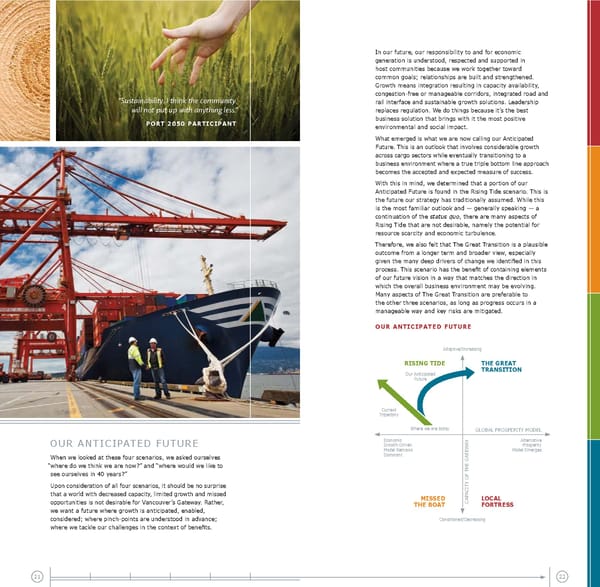in our future, our responsibility to and for economic generation is understood, respected and supported in host communities because we work together toward common goals; relationships are built and strengthened. growth means integration resulting in capacity availability, congestion-free or manageable corridors, integrated road and “Sustainability. I think the community rail interface and sustainable growth solutions. leadership will not put up with anything less.” replaces regulation. We do things because it’s the best business solution that brings with it the most positive port 2050 pArticipAnt environmental and social impact. What emerged is what we are now calling our anticipated Future. this is an outlook that involves considerable growth across cargo sectors while eventually transitioning to a business environment where a true triple bottom line approach becomes the accepted and expected measure of success. With this in mind, we determined that a portion of our anticipated Future is found in the rising tide scenario. this is the future our strategy has traditionally assumed. While this is the most familiar outlook and — generally speaking — a continuation of the status quo, there are many aspects of rising tide that are not desirable, namely the potential for resource scarcity and economic turbulence. therefore, we also felt that the great transition is a plausible outcome from a longer term and broader view, especially given the many deep drivers of change we identified in this process. This scenario has the benefit of containing elements of our future vision in a way that matches the direction in which the overall business environment may be evolving. Many aspects of the great transition are preferable to the other three scenarios, as long as progress occurs in a manageable way and key risks are mitigated. our AnticipAted future Adaptive/Increasing rising tide the greAt trAnsition our anticipated Future current trajectory Where we are today global ProsPerity Model economic y alternative our anticiPated Future growth-driven a Prosperity Model remains teW Model emerges When we looked at these four scenarios, we asked ourselves dominant “where do we think we are now?” and “where would we like to see ourselves in 40 years?” upon consideration of all four scenarios, it should be no surprise that a world with decreased capacity, limited growth and missed acity oF the ga opportunities is not desirable for Vancouver’s gateway. rather, missed caP locAl the BoAt fortress we want a future where growth is anticipated, enabled, considered; where pinch-points are understood in advance; Constrained/Decreasing where we tackle our challenges in the context of benefits. 21 22
 Monitor Deloitte - Final Report Page 68 Page 70
Monitor Deloitte - Final Report Page 68 Page 70